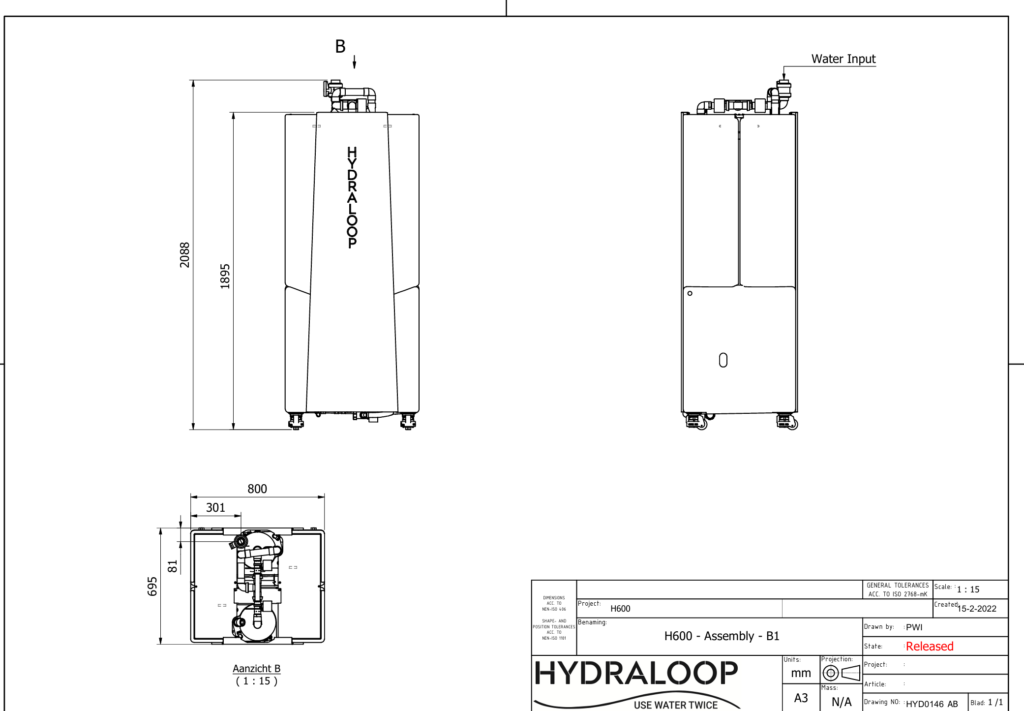PLUMBER/INSTALLER INTRODUCTION
Dear plumber, contractor or installer,
Thanks for working with Hydraloop! In the following pages, you will find a comprehensive overview for the preparation of any building for greywater recycling with Hydraloop. Please
- refer to the Recycle Ready Plumbing Diagram
- check the Plumbing and Installation Guidelines
- follow the instructions below
- co-sign the Recycle Ready Checklist with the device owner before installation.
For a detailed installation overview, please refer to the Installation Manual of the purchased device. If you have any questions about this Recycle Ready Guide or the Installation Manuals, please reach out to support@hydraloop.com.
CUSTOMER INTRODUCTION
Dear Hydraloop customer,
We’re excited to learn that you’re embracing the efficiency of using water twice with Hydraloop. To ensure a seamless experience, let’s confirm that your building is ‘Recycle Ready.’ This guide provides you and your plumber, contractor or installer with the necessary information.
Preparing a building for greywater recycling is straightforward. Essentially, the building needs extra piping to and from the Hydraloop device, along with proper ventilation, power supply and internet access. Looking ahead, new builds worldwide will be designed and constructed with ‘Recycle Ready’ capabilities in mind. Thank you for taking this eco-friendly step with Hydraloop.
Owner Guidelines
This section of the Recycle Ready Guide is crucial for both the future building owner and the Hydraloop device user. Please carefully review the Owner Guidelines and ensure that you sign the Recycle Ready Checklist once all preparations are completed.
Plumbing & Installation Guidelines
The second part of the Recycle Ready Guide provides essential information for the plumber or constructor responsible for preparing the building’s infrastructure. Before the work starts, all parties involved must thoroughly understand both the Plumbing & Installation guidelines. Once preparations are complete, have your construction professional verify and co-sign the Recycle Ready Checklist. Then, send the co-signed checklist to your Hydraloop Partner.
Water Lines Before Installation
Upon achieving the ‘Recycle Ready’ status for the building, all water lines can be made operational, even if the Hydraloop device has not been installed. On the scheduled installation date, your Hydraloop installer will remove the bridge connection, place the device at the agreed-upon location, and establish connections to and from the device.
RECYCLE READY PLUMBING DIAGRAM
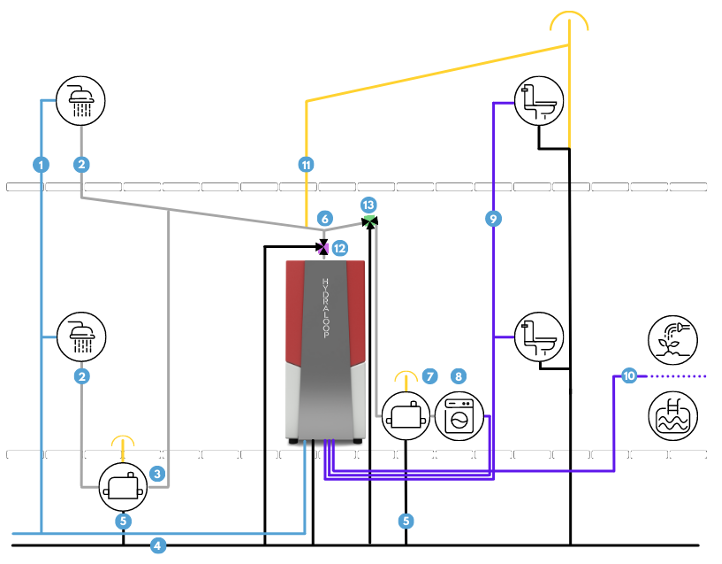
| 1 | Backup water |
| 2 | Greywater and condensation water |
| 3 | Lift pump |
| 4 | Sewage line |
| 5 | Lift pump overflow + maintenance waste (with sewer check valve to prevent backflow) |
| 6 | Greywater and condensation water inlet |
| 7 | Washing machine greywater lift pump |
| 8 | Washing machine reusable water feed |
| 9 | Toilet reusable water feed |
| 10 | Auxiliary reusable water feed (garden or pool) |
| 11 | Ventilation |
| 12 | Manual three-way bypass valve (not included with device) |
| 13 | Electrical inlet diverter (for washing machine greywater input) |
OWNER GUIDELINES

Work with professionals
The preparation of your plumbing network should be completed by a verified professional.

Check your local regulations
Before moving forward with your installation, please check your local guidelines for recycled greywater reuse.

Submit your Recycle Ready Checklist before installation
Before the installation of your Hydraloop device, it is important to ensure the building is Recycle Ready. Together with your plumber or constructor, co-sign the Recycle Ready Checklist and forward it to your Hydraloop Partner for verification. If you do not submit the checklist in time, we cannot verify, and therefore cannot proceed with the installation.

Ask if your Hydraloop installer has a viable HDM login [move down to next steps]
On the agreed installation date, your Hydraloop installer must have a prearranged login for the Hydraloop Device Manager (HDM) with a Hydraloop Sales Engineer. Without this access, activation of the device cannot be performed.
PLUMBING & INSTALLATION GUIDELINES
Size and Location
Location
Hydraloop recommends installing the device in a mechanical or technical room, basement, garage, or a laundry room. Do not install the device outside.
Sound
A Hydraloop device is in action 24/7, collecting, treating, and redistributing water.
The movement of water will produce some sound. Therefore, we do not recommend installing it in a living space.
Temperature
The room temperature should be between 14-35 ˚C | 57-95 ˚F.
Sunlight
Avoid direct sunlight on the Hydraloop device. It is not IP rated or UV resistant.
Greywater Inlet
The greywater inlet and inlet diverter should be positioned at least 2.2m | 87” above the ground.
Service space
Allow at least 70 cm | 28” of space in front of the Hydraloop device face plate for maintenance access. The H300 device will typically be placed against a wall. The H600 device has two sides (left and right) that should be accessible for maintenance.
Plumbing Options
Hydraloop device on a lower floor – input by gravity
Greywater from the shower/bath or other sources is gravity-fed to the top of the Hydraloop device.
Hydraloop device on the same floor – input via lift pump
Greywater from the shower/bath or other sources enters the device through a lift pump.
Optional: Inlet diverter for washing machine
Some Hydraloop models can also treat greywater from washing machines. In this case, the Hydraloop device needs an additional Inlet Diverter.
| HYDRALOOP MODEL | INLET DIVERTER |
| Hydraloop H300 1.5 Standard | not included |
| Hydraloop H300 1.5 with Inlet Diverter | included |
| Hydraloop H300 2.0 Standard | not included |
| Hydraloop H300 2.0 Premium | included |
| Hydraloop H300 2.1 Standard | not included |
| Hydraloop H300 2.1 Premium | included |
| Hydraloop H600 2.0 (Standard and Premium) | included |
| Hydraloop H600 2.1 (Standard and Premium) | included |
Plumbing Guidelines

Input Connections
For H300: Only collect lightly contaminated greywater from shower/bath and washing machine (with optional inlet diverter). Do not connect the Hydraloop device to dishwashers, floor drains, or a kitchen sink.
For H600: Only collect lightly contaminated greywater from shower/bath and washing machine (with optional inlet diverter) and condensation water from air conditioning, heat pump, and tumble dryer. Do not connect the Hydraloop device to dishwashers, floor drains, or a kitchen sink.

Output Connections
The reusable water from a Hydraloop device is suitable for toilet flushing, washing machines, garden irrigation, topping up swimming pools and cleaning purposes. Do not supply bidets and/or hand showers with reusable water.
| Output Outlet | Water Delivery | Pipe size |
| Toilet | permanently pressurised | 1/2″ BSP |
| Washing machine | permanently pressurised | 1/2″ BSP |
| Auxiliary (garden, pool, cleaning) | only pumped if surplus treated water is available | 1/2″ BSP |

Non Potable Water Identification
All outputs from the Hydraloop system must be identified with a non-potable water sign.
Power/Network Requirements
Ensure there is a power outlet or junction box within 1.2 meters | 47“ from the top of each Hydraloop device, as it operates on a 100-120V (60Hz) or 200-240V (60Hz) power supply.
Each Hydraloop device requires a stable internet connection via a stable Ethernet connection or a WiFi network that supports 2.4 GHz frequencies. (All Hydraloop models 2.0 and higher have Ethernet/WLAN functionality.) A reliable internet connection is crucial for tracking the water treatment process and proactively monitoring device functionality.
- Wi-Fi Protocols: 802.11 b/g/n
- Security: WPA/WPA2/WPA3-Personal, WPA2-Enterprise
- Network protocols: IPv4, IPv6, SSL, TCP/UDP/HTTP/FTP/MQTT
Extraordinary Situations
Operation during power outage
Hydraloop devices operate seamlessly using a standard wall outlet. During a power outage, the device automatically switches to its backup batteries to safely drain the tanks, preventing any potential overflow. However, it’s important to note that during a power loss, the device won’t be able to supply water to toilets and/or the washing machine. To ensure continuous water availability, we recommend considering the following backup options:
- UPS (Uninterruptible Power Supply): Invest in a UPS to provide temporary power and maintain the Hydraloop’s functionality during short-term outages.
- Generator: Install a generator to supply continuous power, ensuring uninterrupted operation of the Hydraloop in the event of prolonged power cuts.
- Selective Water Usage: If multiple toilets are in use, designate one toilet to be supplied by tap water during a power outage.
- Backup Bypass to Tap Water: Implement a backup bypass system connecting the device to tap water as an alternative water source during power outages.
Water Hardness
Before installation, please check the water hardness level of the water supplied by your water utility. If the water in your region exceeds 7 grains per gallon or 120–180 mg/L & ppm, we recommend installing a water softener and/or ensuring regular maintenance for scale removal. Descaling is part of the scheduled maintenance program. Your Hydraloop installer will insert citric acid in the shower drain, which enters the Hydraloop device. Then, the device runs an internal cleaning cycle, descaling all essential components.
Water Hardness Scale
| Grains per gallon (GPG) | mg/L & ppm (parts per million) | Classification |
|---|---|---|
| Less than 1 | Less than 17.1 | Soft |
| 1 – 3.5 | 17.1 – 60 | Slightly Hard |
| 3.5 – 7 | 60 – 100 | Moderately Hard |
| 7 – 10 | 120 -180 | Hard |
Lift Pump Requirements
If gravity is not sufficient to move greywater to the Hydraloop device inlet, we advise installing a lift pump. A lift pump might also be necessary to remove wastewater from the Hydraloop device’s waste stream, depending on the device’s location within the building.
Install a lift pump in these 2 situations
1. To lift greywater and/or condensation water from the same floor or below the inlet of the Hydraloop device. For example, the Hydraloop device is placed on the first floor and the shower and washing machine are on the ground floor. The lift pump will pump the greywater up to the inlet of the device.
2. If the Hydraloop device is placed in a basement without a gravity-fed sewer. In that case, install a lift pump to pump wastewater up to the sewer line.
Lift pump considerations
- Control: Hydraloop H300 1.5 devices are equipped with a power outlet at the back of the device for controlling the lift pump. Other models do not have this option.
- Ventilation: Ensure proper ventilation for the lift pump by installing a ventilation stack. Please make sure the ventilation complies with local plumbing legislation.
- Maximum flow: Choose a lift pump that is locally available and has a maximum flow of 45 LPM/12 USGPM. Working with a Hydraloop H300 1.5 device, the lift pump power should not exceed 0.5 HP/2.5 Amp.
- Installation: Please follow the installation instructions supplied by the lift pump manufacturer.
WATER LINES BEFORE INSTALLATION
After the plumbing is set up for greywater recycling and is ‘Recycle Ready,’ you can switch the 3-way greywater selector to bypass mode. This will enable an alternative water supply to feed toilets and/or the washing machine until the Hydraloop device is delivered and set up.
IN THE WALL (H300 only – recommended)
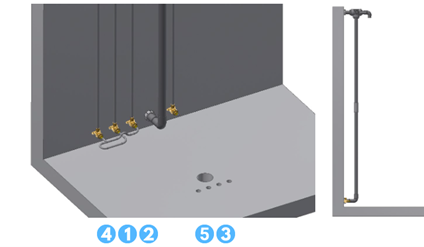
IN THE FLOOR (H300 and H600)
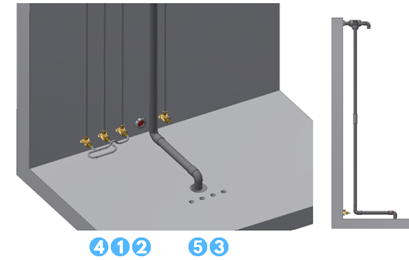
| 1 | Toilet feed Reusable water |
| 2 | Washing machine feed Reusable water |
| 3 | Auxiliary outlet Reusable water |
| 4 | Backup water Tap water or rainwater |
| 5 | Wastewater to sewer |
CONNECTION OVERVIEW
Input connections
Main greywater inlet into the top of the Hydraloop device: 40 mm| 1 ½” OD
- Bring all greywater sources into one dedicated line.
- Please ensure that all greywater lines are separated from blackwater.
- If the greywater input is on a higher floor than the Hydraloop device, gravity will direct the flow.
- In other circumstances, install a lift pump.
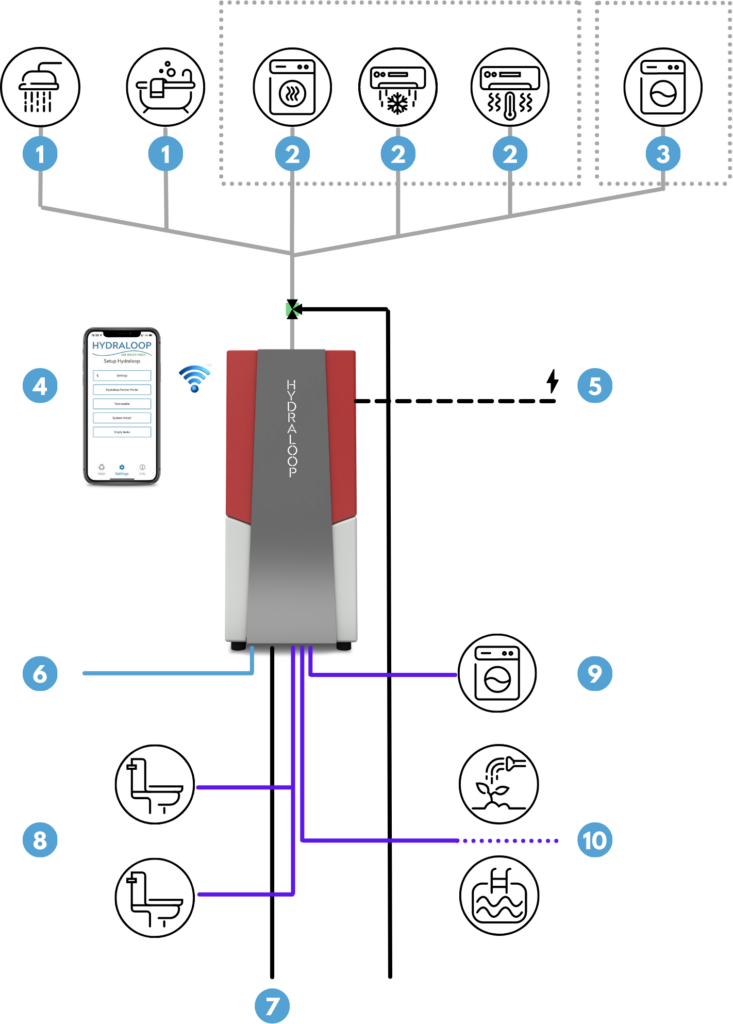
Greywater inlet to the Hydraloop device from
| 1 | H300 and H600 | Shower and bath |
| 2 | H600 | Tumble dryer, Air conditioning and Heat pump |
| 3 | H300 and H600 | Optional: Washing machine (only with inlet diverter) You can connect only one (1) washing machine per Hydraloop device |
Power/Network connections
| 4 | Permanent WiFi internet connection: Bandwidth of 2.4GHz or Ethernet connection Wi-Fi Protocols: 802.11 b/g/n Security: WPA/WPA2/WPA3-Personal, WPA2-Enterprise Network protocols: IPv4, IPv6, SSL, TCP/UDP/HTTP/FTP/MQTT |
| 5 | Power supply: 100-120V (60Hz) or 200-240V Outlet to be within 1.2 m of device |
| 6 | Backup water inlet Tap water or other: 15 mm | ½” MNPT – flow of 12 LPM| 3.2 USGPM If the flow rate is higher than 12LPM | 3.2 USGPM, floater cap and flow regulator. If you use a rainwater pump, install an expansion vessel and 50-micron mesh pre-filter. |
Output connections
| 7 | Wastewater outlet Connection to sewer: 40 mm | 1½” OD (min. of 50 mm | 2”) with rubber sleeve Wastewater from the Hydraloop device to sewer (gravity) operates on a timer for wastewater release every 7 days. |
| 8 | Toilet flushing (pressurized): 15 mm | ½” MNP |
| 9 | Washing machine (pressurized): 15 mm | ½” MNPT |
| 10 | Auxiliary outlet (non-pressurized): 15 mm | ½” MNPT |
TECHNICAL DRAWINGS
Front view of H300 and H600
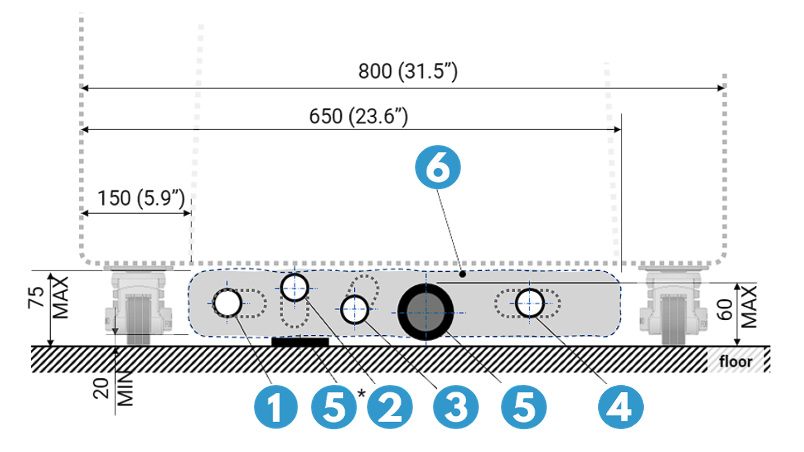
Top view of H300 (all dimensions in mm (inches))
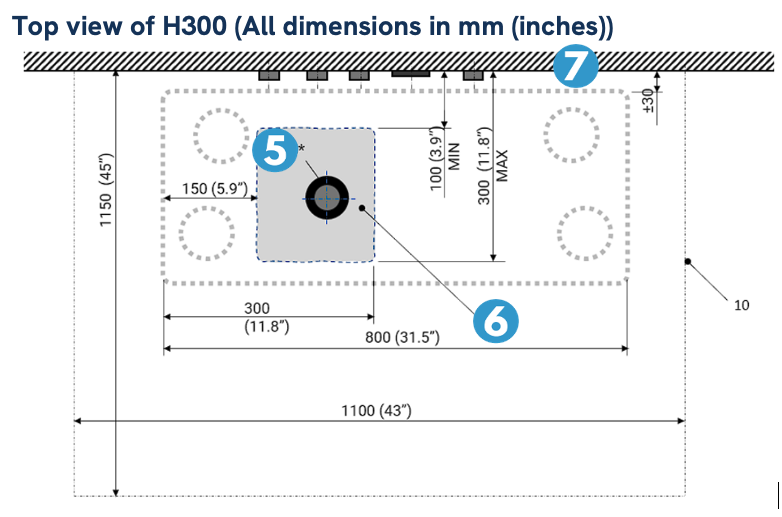
Top view of H600 (all dimensions in mm (inches))
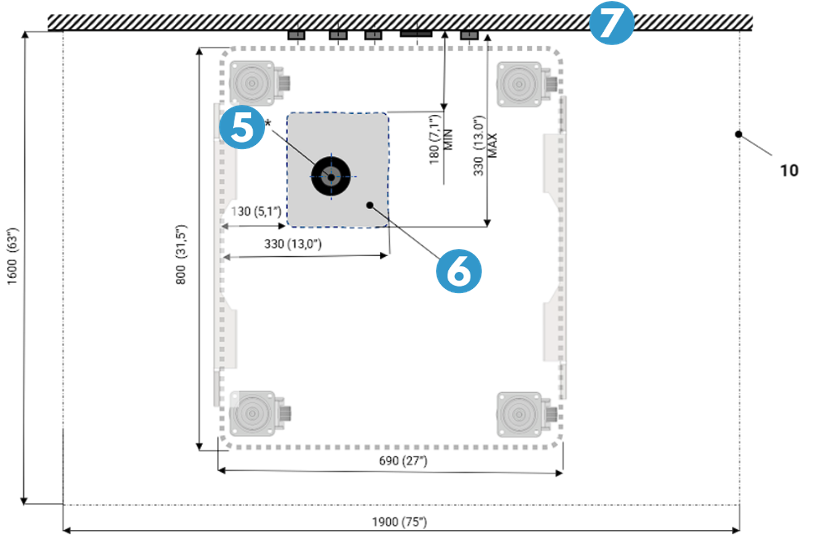
| 1 | Auxiliary outlet Reusable water: connect with flexible hose provided |
| 2 | Toilet feed Reusable water: connect with flexible hose provided |
| 3 | Washing machine feed Reusable water: connect with flexible hose provided |
| 4 | Backup water Tap water and rainwater |
| 5 | Wastewater to sewer in the wall 50-75mm | 2 – 3” sewer connection with rubber manchet |
| 5 | *Wastewater to sewer in the floor: 50-75mm | 2 – 3” sewer connection with rubber manchet |
| 6 | Allowed area |
| 7 | Wall |
SYSTEM SPECIFICATIONS
| Hydraloop H300 | |
| Volume | 300 liters | 80 gallons |
| Cleaning capacity | 360 liters | 95 gallons per day depending on user behavior |
| Voltage | 100 / 240V, 24V internal |
| Average power consumption | 220 kWh/year, 25W during treatment |
| WiFi | The Hydraloop device needs to be connected with an internal WiFi-network |
| Sound Level | ± 44 dB. |
| Greywater input sources | – shower – bath – washing machine (with inlet diverter) |
| Hydraloop H600 | |
| Volume | 600 liters | 160 gallons |
| Cleaning capacity | 850 liters | 225 gallons per day depending on user behavior |
| Voltage | 100 / 240V, 24V internal |
| Average power consumption | 460 kWh/year, 53W during treatment |
| WiFi | The Hydraloop device needs to be connected with an internal WiFi-network |
| Sound Level | ± 46 dB |
| Greywater input sources | – shower – bath – tumble dryer – air conditioning – heat pump – washing machine (with inlet diverter) |
NEXT STEPS
GLOSSARY OF TERMS
Auxiliary Outlet
This valve allows for the distribution of reusable water to be used for the garden, irrigation, or pool top-up (depending on your region). This outlet is non-pressurized.
Backup water
Water that is used as a main source of water in the building. This could be tap water, municipal water, well water, rain water, etc. Another term for backup water is ‘mains water’.
Blackwater
Contaminated wastewater containing pathogens from human waste and other organic materials. This waste stream can come from toilets, bidets, hand showers, floor drains, dishwashers, and kitchen sinks.
Greywater
Lightly contaminated domestic water from the drains of baths, showers and washing machines.
Hydraloop app
This is an app that device owners can download on their smartphone. The app monitors how a Hydraloop device is functioning, offers tips on how to save more water and gives encouragement when water savings in the building are at a high level. The app will notify the owner when the 21-day Activation date (and a minimum of 20 showers/baths) has been reached and when the device is ready to distribute reusable water.
Hydraloop Device Manager (HDM)
Online monitoring system for the Hydraloop device. During installation, this platform is used for testing, verification, and activation of the Hydraloop device. After installation, the HDM is used for monitoring, maintenance, troubleshooting and ticket generation. Before installation of a Hydraloop device, the HDM requires login credentials, provided by Hydraloop. Please ask your Hydraloop installer if your device has a viable login-code before installation.
Inlet diverter
This optional valve allows for the intake of greywater from sources other than the shower/bath i.e. the washing machine. By adding this valve to the inlet of the Hydraloop device, greywater from the washing machine can be treated for reuse.
Recycle Ready Guide
This is a guide provided by Hydraloop, aimed at device owners, plumbers, and contractors. The Recycle Ready Guide explains how to prepare and configure the plumbing network in a building, so it is ready to receive and recycle greywater.
Recycle Ready Checklist
Once preparations are complete, the Hydraloop owner and construction professional verify and co-sign the ‘Recycle Ready Checklist’. Then, the Hydraloop owner sends the co-signed Checklist to their Hydraloop Partner. Without a signed and verified Recycle Ready Checklist, an installation date cannot be planned.
Reusable water
Greywater that has undergone various steps of treatment to be reused for toilet flushing, water for the washing machine and/or outdoor uses (irrigation, pool top-up).
Start-up Time
The Hydraloop device requires a minimum of 21 days (3 weeks) or 20 showers to develop the biological treatment process in the T2 tanks and become fully operational. If the device has not sensed 20 showers by 21 days of operation, the start-up time will last longer.
Ventilation
This is placed along the greywater line to prevent anti-siphoning of water out of airlock. Ensure that the greywater input and sewage output both have proper two-way ventilation. Ventilation for greywater input should be above all greywater lines and end outside the building.
Dimensions and weights Hydraloop H300
| HYDRALOOP MODEL | WIDTH (MM) | DEPTH (MM) | HEIGHT (MM) | DRY WEIGHT (KG) | WET WEIGHT (KG) |
| H300 (Inlet standard) | 800 | 335 | 2095 | 82,5 | 383 |
| H300 (Inlet Diverter) | 800 | 335 | 2095 | ||
| H300 PACKAGED | 815 | 800 | 2198 | 90,5 | – |
| H300 DISPLAY MODEL | 810 | 335 | 2045 | 40 | – |
| H300 DISPLAY MODEL PACKAGED | 815 | 345 | 2198 | 50 | – |
| HYDRALOOP MODEL | WIDTH (INCHES) | DEPTH (INCHES) | HEIGHT (INCHES) | DRY WEIGHT (POUNDS) | WET WEIGHT (POUNDS) |
| H300 (Inlet Standard) | 31.49 | 13.19 | 82.48 | 181.91 | 844.52 |
| H300 (Inlet Diverter) | 31.49 | 13.19 | 82.48 | ||
| H300 PACKAGED | 32.08 | 31.50 | 86.54 | 199.55 | – |
| H300 DISPLAY MODEL | 31.88 | 13.19 | 80.51 | 88.20 | – |
| H300 DISPLAY MODEL PACKAGED | 32.08 | 13.58 | 86.54 | 110.25 | – |
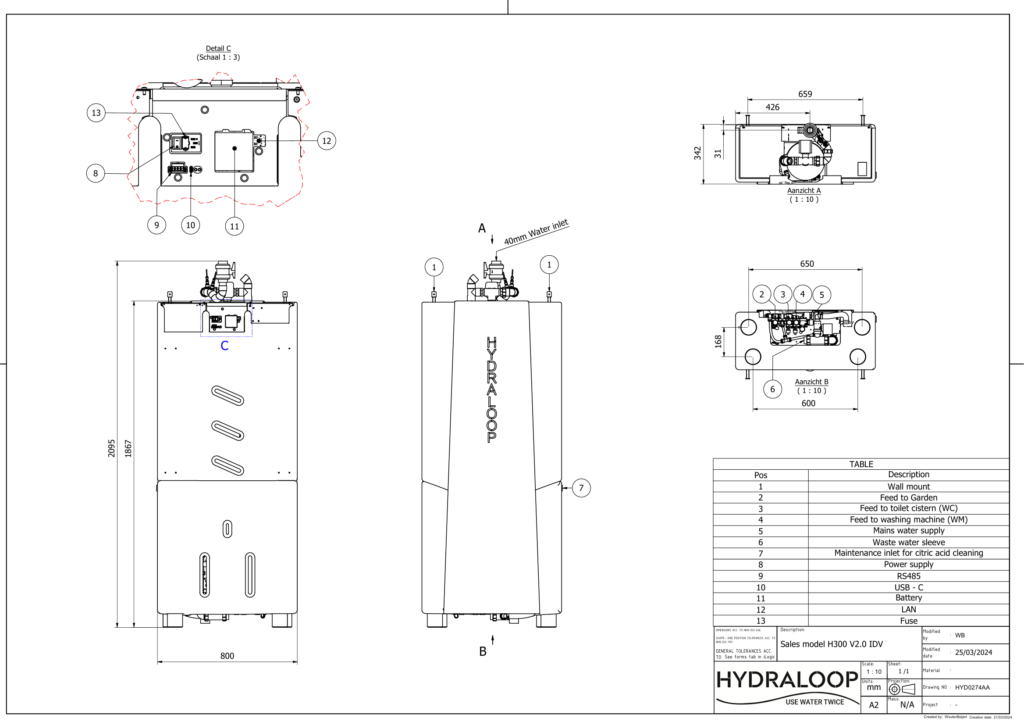
Dimensions and weights Hydraloop H600
| HYDRALOOP MODEL | HEIGHT (MM) | WIDTH (MM) | LENGTH (MM) | DRY WEIGHT (KG) | WET WEIGHT (KG) |
| H600 | 2080 | 680 | 810 | 128 | 739,5 |
| H600 PACKAGED | 2190 | 705 | 820 | 138 | – |
| H600 DISPLAY MODEL | 2080 | 810 | 720 | 62 | – |
| H600 DISPLAY MODEL PACKAGED | 2190 | 705 | 820 | 72 | – |
| HYDRALOOP MODEL | WIDTH (INCHES) | DEPTH (INCHES) | HEIGHT (INCHES) | DRY WEIGHT (POUNDS) | WET WEIGHT (POUNDS) |
| H600 | 31.49 | 26.77 | 82.20 | 282.24 | 1630.60 |
| H600 PACKAGED | 32.28 | 27.76 | 86.22 | 304.29 | – |
| H600 DISPLAY MODEL | 31.49 | 26.77 | 82.20 | 136.71 | – |
| H600 DISPLAY MODEL PACKAGED | 32.28 | 27.76 | 86.22 | 158.76 | – |
